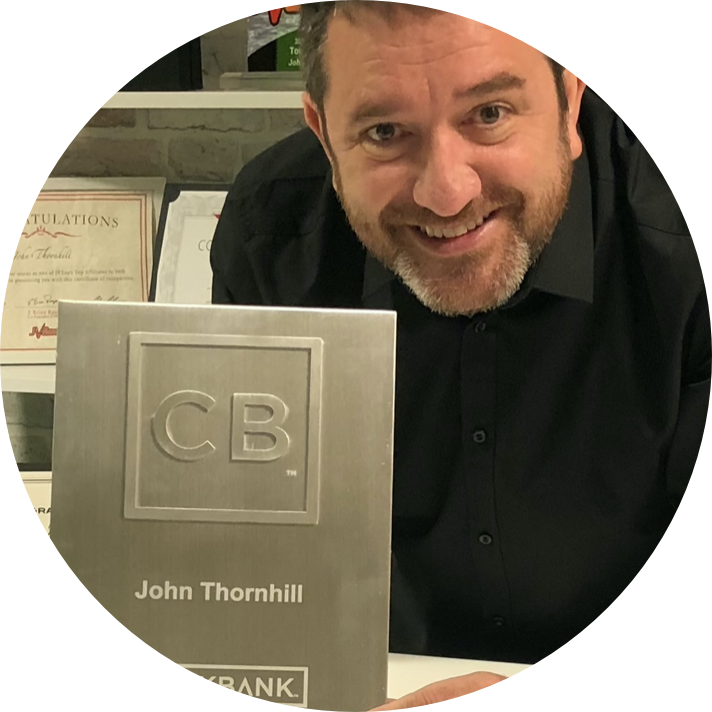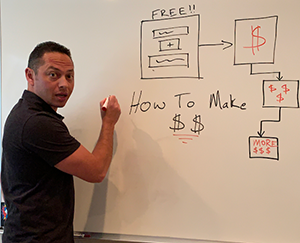Simple Shifts To Turn Average Speakers Into Expert Communicators written by John Jantsch read more at Duct Tape Marketing
The Duct Tape Marketing Podcast with Michael Hoeppner In this episode of the Duct Tape Marketing Podcast, I interviewed Michael Chad Hoeppner, a political communications expert known for his work with Andrew Yang during the 2020 presidential election. As an adjunct professor at Columbia Business School, Hoeppner has conducted deep dive research on the speaking […]
Simple Shifts To Turn Average Speakers Into Expert Communicators written by John Jantsch read more at Duct Tape Marketing
The Duct Tape Marketing Podcast with Michael Hoeppner
In this episode of the Duct Tape Marketing Podcast, I interviewed Michael Chad Hoeppner, a political communications expert known for his work with Andrew Yang during the 2020 presidential election. As an adjunct professor at Columbia Business School, Hoeppner has conducted deep dive research on the speaking habits of Hillary Rodham Clinton, Joe Biden, Gretchen Whitmer, and others.
Hoeppner is the CEO and president of GK Training, a firm dedicated to giving individuals, companies, and organizations the communication skills necessary to reach their highest goals in work and life. He has worked with some of the world’s most influential companies and their leaders. Hoeppner is also the author of “Don’t Say Um: How to Communicate Effectively to Live a Better Life.”
Our conversation spans the art of effective communication, uncovering actionable public speaking tips and simple exercises to transform average speakers into confident, expert communicators. Whether you want to eliminate filler words, speak with intentionality, or learn how to engage an audience effortlessly, Hoeppner’s insights offer practical tools for anyone looking to become a better speaker and communicator.
Key Takeaways:
- Effective communication starts with intentionality
Hoeppner emphasizes shifting focus from yourself to your audience. Understanding that speaking is about serving others, not showcasing yourself, can immediately elevate your communication skills. - Filler words aren’t the enemy—lack of clarity is
Instead of obsessing over eliminating “ums” and “ahs,” focus on increasing linguistic precision. Choose your words intentionally to ensure your message resonates. - Public speaking is an extension of everyday conversation
Hoeppner reframes public speaking as simply communicating in front of an audience. By breaking the false divide between casual and formal speaking, you can bring authenticity and confidence to any setting. - Use practical exercises to master intentional communication
Techniques like the Lego Drill or finger-walking exercises can help you slow down, organize your thoughts, and speak with clarity and impact. - Tolerating silence is a game-changer
Pauses give your brain time to think, your voice time to breathe, and your audience time to process. Learning to embrace silence can be a transformative skill for better communication.
Chapters:
- [00:00] Who is Michael Chad Hoeppner?
- [01:58] Why Every Conversation is Public Speaking
- [03:22] Shifting from Self-Focus to Audience Focus
- [04:20] Understanding Filler Words and How to Replace Them
- [07:41] The Lego Drill for Organizing and Slowing Down Your Thoughts
- [10:29] Why You Should Unitask Instead of Multitask
- [16:18] Tolerating Silence and Embracing Pauses
- [18:57] Practical Exercises for Better Speaking Habits
- [20:06] Balancing Rehearsal and Spontaneity in Public Speaking
- [23:12] Navigating Mistakes with Confidence and Humor
- [24:48] Tools and Resources from Don’t Say Um
More About Michael Chad Hoeppner:
- Don’t Say Um: How to Communicate Effectively to Live a Better Life by Michael Chad Hoeppner
- Check out Michael Chad Hoeppner’s Website
- Connect with Michael Chad Hoeppner on LinkedIn
This episode of the Duct Tape Marketing Podcast is brought to you by
Nobody does data better than Oracle. Train your AI models at twice the speed and less than half of the cost of other clouds. If you want to do more and spend less, take a free test drive at Oracle.
John Jantsch (00:00.878)
Hello and welcome to another episode of the Duck Tape Marketing Podcast. This is John Jantsch and my guest today is Michael Chad Hoeppner. He is a political communications expert known for his work with Andrew Yang during the 2020 presidential election. And as an adjunct professor at Columbia Business School, Michael Chad Hoeppner has conducted deep dive research on the speaking habits of Hillary Rodham Clinton, Joe Biden, Gretchen Whitmer and others.
He’s the CEO and president of GK Training and author of a book we’re going to talk about today. Don’t Say How to Communicate Effectively to Live a Better Life. So Michael, welcome to the show.
Michael Chad Hoeppner (00:41.068)
Thank you so much. Pleasure to be here.
John Jantsch (00:43.578)
Okay, I have to start with the big promise. How is this going to help me live a better life?
Michael Chad Hoeppner (00:49.484)
Yeah, well, it will and I’ll tell you why. Because you speak and you communicate so much more than you actually recognize. I know that seems obvious, but we say, depending on the day, between five and 10,000 words a day. So if people think of this kind of training as compartmentalized into public speaking, it’s a total waste. And it’s not even true. I mean, I often joke that…
Every time we’re speaking it is some form of public speaking. If there’s an audience we’re speaking and it’s theoretically in public. And actually breaking down that idea, that very false distinction between what is public speaking and what is the rest of your life is an important task because it allows you to recognize how much of your life is actually influenced and determined by how effectively you can talk to other folks. And by the way,
If you learn to talk a little bit better too, you’re moving your body differently, you’re breathing differently. So in a very microscopic way, it’s actually a tiny moment of exercise and health and wellness in your day. So those are some of the ways it makes your life better.
John Jantsch (01:58.626)
And I suspect most people, I know I do, I most people do what we do almost unconsciously sometimes, especially we’re having a conversation with a friend one to one. It’s just like, you know, I’m slouching, I’m saying, I’m doing whatever. And a lot of it really is intentionality, isn’t it?
Michael Chad Hoeppner (02:16.204)
Yeah, yeah. Go farther with the metaphor you just talked about. On the one hand, we can kind of have fun with a thought experiment of if I’m talking to my friend, I’m slouching and just being really casual. But there’s a different version of that too, which is think of the really engaging conversation with your friend or even more of the point, think of it when your friend’s having a hard time and you’re trying to help them. And in that situation, how you communicate is entirely
because of your ability to be other focused. You’re not thinking about your presentation skills and am I moving my hands too much or not enough? You’re just thinking about them, which to your point is exactly why we’re able to do it so freely, so dynamically, so unconsciously. And then what happens is we cross this very fraught divide when we shift into self-focus.
whether that’s from giving a speech or being in an interview or any other high stakes communication situation, and it all becomes really problematic as we fixate on ourselves as opposed to the other person.
John Jantsch (03:22.222)
funny, I’ve done a lot of what you’re calling public speaking over the years. And I remember early on, had a mentor, somebody, you know, kind of helping me. And he said, the minute you realize it’s not about you, you know, you will be a better speaker. And it took me a long time to figure that out. It’s like that they’re not there to see me entertain them. They’re there to get some sort of transformation or some sort of message. And boy, it takes a little while, but now I
don’t even think about, you know, speaking to public. I’m like, how am here to serve?
Michael Chad Hoeppner (03:53.174)
Yeah, that service mindset is really powerful. It’s really powerful.
John Jantsch (03:59.002)
So let’s go to the ums, which thankfully now AI can just edit right out. We don’t have to worry about. But we call them filler words, right? And there’s a whole list of them. I’m right is another one. What does that tell about somebody’s communication habits?
Michael Chad Hoeppner (04:20.172)
Yeah. Well, I call my book, Don’t Say It’s a trick and the reader will learn that on the first page when you just look at the preface. It’s a trick because don’t say is the worst advice you can give yourself. It’s self-focused. It’s thought suppression, which we’re terrible at. But I knew because people really want to address this pain point, I knew it’s a way to help them actually recognize I should get this research and I should try to help myself improve in these ways.
I often say that I’m not the police, okay? I’m not saying it’s a sin or a commandment that one can never say In fact, let’s say you say every, I don’t know, 20 seconds, 25 seconds when you’re in that situation with your friend we just talked about trying to help them. Fine. You’re probably using it in the middle of a free form conversation. You’re searching for a word. But what I am very interested in…
is if when you get into the more self-focused situation, the interview, the big presentation, if the number of ums skyrocket and all of sudden you’re saying one every three seconds or five seconds, those ums actually are worth looking at because what they’re coming from is essentially you feeling some kind of pressure to fill silence or speak at a certain rate of speech or strive for some kind of vocabulary to demonstrate how smart you are or something. They’re coming from a not so useful.
So the tool that I often talk about when it comes to is that what you’re really trying to do is develop your linguistic precision. Meaning not the UM’s I’m trying to avoid, but what are all the useful, accurate, potent words instead of the that I’m actually trying to grab onto. And I will often even use what’s called embodied cognition, learning by using your body, to have people walk their fingers
across a desk like this, like I’m doing now on the… You can’t see this if you’re just listening on audio, but if you’re looking at the video, of course, walking your fingers across the desk, step by step, forcing yourself with those small little finger steps to actively choose language. So as opposed to policing yourself to never say any filler, my point really is, sure, you’re probably going to say some filler, but the real battle and the real joy actually is hunting for those words that you do want to choose.
Michael Chad Hoeppner (06:45.292)
as opposed to the little sounds you’re trying to avoid.
John Jantsch (06:49.186)
And a lot of it has to do well if it’s confidence or comfort level I mean a lot of those things like you said they come out when people are nervous more so so that a lot of times they naturally come out when somebody who is a nervous in front of an audience does it but you know, do you and I actually I was gonna go to your Your exercises and I love the attaching a physical thing to doing that because it really does bring you you know right there to where you’re thinking about the fingers
I had another one up there that I’d love for you to go to the exercise. can’t find it here. lay the Lego drill, for again, enhancing kind of memory and, and, and I love, cause I think a lot of people just feel like, I just got to get out there and practice and do it a lot, but there actually are techniques, right? Right. Practice. that gets you there. So talk a little bit about, the Lego drill.
Michael Chad Hoeppner (07:25.879)
Yeah.
Michael Chad Hoeppner (07:41.932)
Yeah, sure. You’re 100 % right to call that distinction about practice. I mean, you’ve heard sports coaches talk about this. There’s very much a difference between just practicing and then also practicing in the right way. So if you’re listening to this, if you know about yourself, when you’re in high stakes speaking situations, you talk a mile a minute, you talk as fast as you possibly can to try to fill out any sounds at all, just practicing doing more of that is actually not gonna help.
So the drill works like this and the preferred tools are in fact Lego blocks. And the reason is, is because of that little clicking function where they click together. First of all, it’s very satisfying. Second of all, it takes some time. You can’t rush it. So it enforces a little tiny bit of time discipline. The way the exercise works is this, is that you’re going to share some content, whatever it is, it could be, you know, an elevator pitch or the beginning of a presentation or really anything.
John Jantsch (08:19.96)
Yeah.
Michael Chad Hoeppner (08:37.152)
an essential answer to an interview question, whatever you want. And as opposed to just opening your mouth and seeing what comes out or trying to remember all the smart stuff you’re gonna say, no. You’re gonna say one idea and then you’ll say another one and then another one, but you’re gonna start with a single idea. So you have a number of Lego blocks with you, five, seven, whatever it is. Before you even begin, in silence, you pick up the first Lego block.
And then you say the first idea you want to share. You could think of this like the first sentence, but humans, think in ideas or thoughts, not so much sentences. anyway, you say the first idea or sentence, and at the end of it, in silence, kind of like where the period might go at the end of that sentence, you put the Lego block down on a table or a desk. Now you have to remain silent as you pick up the second Lego block. Once you have that second Lego block in the air,
Then you can share the second idea, whatever that might be. Blah, blah, blah, blah, blah, blah, blah. At the end of that idea, in silence, you click the second Lego block in place with the first. And that’s where that moment of clicking takes place. Third idea is the same thing, fourth, fifth, et cetera. Now the brilliance in this, and I don’t mean to say brilliance meaning I’m brilliant. I mean that you’re brilliant, you who are reusing it. The brilliance in this is that it
John Jantsch (09:55.205)
Hahaha.
Michael Chad Hoeppner (10:01.666)
gives your brain the opportunity to unitask rather than multitask. All you have to do is think of one idea you wanna share. Not 25 you’re trying to remember to get through as fast as you can so you don’t forget them. One, confident that at the end of that idea your brain will do what it’s miraculously good at which is considering a next idea you want to share. And so what this tends to do is A, slow you down, B,
John Jantsch (10:07.546)
Mm-hmm.
John Jantsch (10:25.412)
Yeah.
Michael Chad Hoeppner (10:29.886)
structure your thoughts much much better and see make you oftentimes much briefer to a more concise
John Jantsch (10:36.238)
You know, as funny as I listen to that too, I know that as I’ve gone from say a 30 minute talk to a 90 minute talk, but maybe on the same topic, it does become sort of bits that connect together and you just have to get to the end of the bit, you know, is all you have to remember. And then it’s like, no, now it’s the next bit. so it really helps for that kind of structure too, doesn’t it?
Michael Chad Hoeppner (10:48.515)
Yeah.
Michael Chad Hoeppner (10:59.405)
for sure. I mean, I would go one further, which I would say the great impromptu speakers of all time, they have mastered this skill. It’s what allows someone to speak for 20 minutes, totally free form, but looking as though they have memorized this incredibly polished speech. They have just built this ability, almost like an athlete, to share one idea, knowing full well at the end they have a moment to think about what to say next.
John Jantsch (11:26.702)
So you actually start out the book talking about people being that speaking itself is an innate ability pretty much everybody is born with. How do you, I there’d be a lot of people that would disagree with that. So how do you get people back to that, that sort of, you know, starter state that, everybody’s born with, if they just have this fear like, or they society has somehow taught them that they’re not a good speaker.
Michael Chad Hoeppner (11:52.064)
Yeah, well, let me tweak a little bit the question because I actually don’t suggest that speech is innate. I would suggest that the ability to learn speech is innate and that we certainly learn speech over a period of time. But here’s the test of it. If you drop any kid in any culture anywhere as a newborn and let them grow up to age five or 10, they will speak the language fairly fluently. Writing is the proof point.
If you don’t instruct the kid how to write, they don’t learn that. It doesn’t just automatically kind of sink in. There’s a bunch of processes we go through to learn how to speak by watching each other, by mimicry, things like this. Now, to be clear, audience, I am an expert in many things that I do. very good at what I, I should say, I like to think I’m very good at what I do, but trust me, I do not do everything. And there’s a bunch of stuff I’m bad at and I’m not an evolutionary biologist, okay?
So I’m not saying necessarily what our evolutionary trajectory is. What I will say though is when you listen to a six-month-old kid scream all night long and wake up the next day with vocal cords that are ready to scream for 12 more hours, and you think about a full grown adult doing that same exercise and knowing how they would be completely hoarse. And if they did that for a few days, it would begin to already develop vocal nodes.
There’s something going on about how we create sound and language as little kids and how we do it much, worse as adults. So to get people back to speaking how they do when they’re much younger, which is freely expressing and make it very basic, turning air into sound and sound into words, we have to unlock how people talk when they’re at their most other focused. Last thing I’ll say about that, by the way, is
where there’s really interesting crucible moment in our society, which is partly because of devices and screens, some kids aren’t learning as much how to communicate face to face as in previous generations. So even some of what I just said in that answer might actually change over the next half decade, decade and more.
John Jantsch (14:06.626)
I’m curious, and this kind of touches on that, how much of your coaching, of course, is the words that are said and how they’re said, but how much of it is not the words? It’s who you are, who you’re being, your presence, all those things, which again, comes across different in person than it does across the virtual screen.
Michael Chad Hoeppner (14:24.12)
Yeah.
People who are interested in this, as a preview, the entire book is on delivery. This book doesn’t even touch on content at all. So to answer that question based on this book, would be a hundred and zero actually. But in my actual practice, I would say it’s, know, typically of two thirds, one third. So the majority is on delivery, but more than even just the balance of the two or how much time is spent in either one, the thing I’m really just obsessed by
and fascinated about is how, as opposed to fighting about which one matters more, how you can unlock a virtuous cycle in which each one makes the other better. And that you can enter that cycle really from either side, from content to delivery or delivery to content. And you can enter it from delivery to content. In other words, if you just practice speaking with more breath, more vocal variety, tolerating more silence,
John Jantsch (15:19.289)
Mm.
Michael Chad Hoeppner (15:21.954)
Your voice sounds better because it has the fuel it needs to actually sound resonant and full. But with that breath, with that silence, your brain has what it needs to think of smart stuff to say, which is oxygen and time. So the two things exist in this very complimentary dynamic that really can go into a virtuous or also, by the way, bad news, a vicious direction.
John Jantsch (15:48.058)
You mentioned tolerate silence. And I want to go there for a minute because I found that in my speaking, one of the hardest things to do, let alone learn. When I started speaking, you know, and I had a speaking coach and he was like, you need to give this like three seconds before you say another word. And I was like, when I did it the first time, that was an eternity. And I think that a lot of people struggle, but I’ve heard more and more folks like yourself talk about how important that is, how impactful that silence can really be.
Michael Chad Hoeppner (16:18.102)
Yeah, I’ll give you a few things to frame this. The first is that people get all hung up on rate of speech. How fast should I talk? And it’s incredibly intuitive if you actually think about it. Rate of speech is really just three things that frame it or that anchor it. One, how much time you need to think of smart stuff to say. Number two, how much time you want to give your audience to digest the smart stuff you said.
And then number three, how long it takes to enunciate those smart things. That’s what determines it. So pauses when we’re at our most other focused come from this very organic place, which is I need a moment and think about what I want to say or powerfully, I’ve just said something hopefully important to the person I’m talking to and I want to give them a moment to digest it. And I’m watching them like a hawk to see when they are…
demonstrating to me comprehension or acknowledgement or recognition, and that cues to me, okay, they’re ready to digest the next idea. That’s where it comes from. Now, when we’re at our most other focus, we do that seamlessly. And then when we feel like it’s all about us, to your point, we talk a mile a minute and we never pause. And our perception can be off on this, by the way, dramatically. And if you don’t believe me, in some video software tool, run some meeting that you’re very nervous about, all right? Lead the meeting.
record the whole meeting afterwards, watch it back, and tell me how long you thought the longest pause was, and you’re gonna see it was like a quarter of a second, and it felt to you like an eternity. So to your point with the speaking coach you work with who made you tolerate this eternity of time that was three seconds, there’s a bunch of tools you can do to actually quite quickly.
John Jantsch (17:48.878)
and
John Jantsch (17:54.104)
Yeah.
Michael Chad Hoeppner (18:05.41)
Build some skill with us. I’ll give you one. And this was actually, we had a nice little feature in the Wall Street Journal a couple of weeks back on this where they used this as one tool that we suggested. On video calls, when you’re asking people questions, do this little trick. At the end of the question, draw a question mark on your desk and be completely silent while you do that little activity. No one can see you’re doing it. Cause we have this, you know, as I’m just demonstrating right now, this.
what I would call a digital cloak of invisibility. People can’t see your hands, but it gives you this physical intervention to force you to actually live through that silence. And it gives you something to occupy your attention, which is drawing the question mark. But here’s a second quick idea. Anybody with a smartphone, you can do this. Open your notes video, you know, not video, what is it called? the voice memo app and record yourself talking.
John Jantsch (18:36.121)
you
John Jantsch (18:57.434)
Right, right, right.
Michael Chad Hoeppner (18:59.852)
and then look back at it and watch the little wave file that has those kind of spikes and valleys. Now look at what is the longest pause in your whole span of speaking. And you probably felt like three seconds, four seconds, bet you it’s half a second long. And so that’s a very quick way to see, wow, these are not nearly as long as I thought. And I actually could afford to have more of them in lengthier.
John Jantsch (19:25.828)
A lot of folks you talk to about speaking, know, practice, practice, practice, rehearse, rehearse, rehearse is, know, especially again, talking about the public speaking. But I’ve found that some of the best moments I’ve heard public speaking is when something happened and went off the rails and I reacted spontaneously. know, those are always the moment that everybody looks back on. Do you feel like people that
that actually practice makes those happen because you get so confident or, know, I mean, again, what I’m really trying to ask, let me get to the question now is how do you keep spontaneity when you know that you have to rehearse?
Michael Chad Hoeppner (20:06.572)
Yeah. This comes down to a little bit of actor training actually, which is people, if you’re trying to really become very solid on some content and you do care that it’s close to almost word perfect, or I’ll give you an example, if you have a three minute pitch, it really does need to be three minutes, it can’t be three and a half as an example, then your script has to be pretty tight. But people memorize the wrong thing. People memorize the wrong thing. People memorize the wrong thing.
People memorize the wrong thing. And no, by the way, don’t stop listening folks. There was not a glitch in the audio. I repeated the thing four times in a row. What they memorize is what actors call a line reading. So they memorize the delivery. They don’t just memorize the words. So their pace, pitch, pause, power, and placement, those are the five P’s of vocal variety, their pace, pitch, pause, power, and placement becomes identical every single time.
John Jantsch (20:39.544)
Ha ha ha.
Michael Chad Hoeppner (21:05.304)
they practice saying those words. So what happens? They stand up or they attend the meeting or whatever it is to do the actual thing and they sound totally robotic because they’ve beaten all the life out of these words by practicing these kind of relentless line deliveries. So if you want to learn the content, practice the content, but this time folks, you have to change the delivery every single time to keep that loose and spontaneous.
Walk around the room and swing your arms like a big slow elephant. And then the next time, say it as though you’re speaking on the top of a cliff to a giant army of people who are extending way back. And the next time, talk into a phone as though you’re at a library and you’re trying not to be overheard by the library. I know this sounds extreme, what I’m doing, but you want to break that muscle memory of
I’m rigidly clamping down on how I talk for the purpose of making sure I remember every word. It ends up sounding robotic. Now to your point about spontaneity, then if you rehearse those things in that way with some freedom of delivery, you’ve ingrained a looser experience of speaking, so it sounds more spontaneous. And then mistakes, we can get to how to deal with that if you want to. That’s a second thing, but that will help come across much less like…
overly rigid and overly polished.
John Jantsch (22:30.434)
I always love those videos of comedians that they’ll just be asking people questions and then they’ll just go on a whole thing, know, based on some of that they build up library, you know, because people ask the same questions, but I always find those really fascinating.
Michael Chad Hoeppner (22:43.79)
Yeah. Yeah. You want to talk for a second about how to navigate mistakes? Is that useful? Yeah, sure. Sure. So people often go into these three F’s when it comes to mistakes, when they’re in an adrenaline response, when public speaking or something. And of course the three F’s are the human threat response, which is, you know, fight, flight or freeze. And so I will often suggest to clients that they replace those three F’s with these three F’s, which are fake it.
John Jantsch (22:48.248)
Yeah, let’s do it. Let’s do it.
Michael Chad Hoeppner (23:12.952)
feature it or fix it. And so the fake it means if no one knows, but it’s not throwing off, fine, fake it. You don’t need to tell us every time you make a mistake in life. But if it is threatening to throw you off, then you can either fix it, which means you just acknowledge it, address it and keep going. Or you actually feature it, which I would guess is what you have developed the skill to do. Because you mentioned sometimes these moments happen and they’re some of your favorite moments that I bet
whether it’s via humor or kind of rapport building with the audience that you actually feature those moments in some way, you spin them as a slightly good thing or a positive accident. But I’m just guessing, does that resonate with you?
John Jantsch (23:56.29)
Yeah, yeah, no, absolutely. Yeah, yeah, I definitely try to lean towards humor. Yeah.
Michael Chad Hoeppner (24:01.228)
Yeah, yeah. And those moments can create as much humanity as anything else, know? Create tremendous moments of spontaneity and also empathy, because the audience relates very much to you.
John Jantsch (24:13.851)
Yeah. Yeah. Some of them were just as nervous as you, right? About your performance. I’ve always found that too. They want you to succeed. It’s great. Yeah. It’s funny on the mistake thing. I had a music teacher early on in life that said, you know, if you make a mistake on this part, just make sure you make it again. The next time we go through, nobody will notice.
Michael Chad Hoeppner (24:18.52)
for sure.
Yeah, for sure. Yeah.
Michael Chad Hoeppner (24:35.106)
That’s good.
John Jantsch (24:37.207)
Well, Michael, I appreciate you taking a few moments to stop by the Duct Tape Marketing Podcast. Is there somewhere that you’d invite people to learn about your work and certainly find a copy of Don’t Say I’m
Michael Chad Hoeppner (24:48.0)
Yeah, it’s really simple. You can just go to don’t say um.com. That’s where to find me, where to find the book, where to find all that stuff. And I will say that the site is a great place because we give not just information and access to the book and things like that, but we also have a whole bunch of video drills and exercises. So if the ones I was talking about, the Lego drill or the finger walking or even the drawing of the question mark, if these are interesting, you actually get guided videos about how to do them.
So you can just check them out at don’tsayum.com.
John Jantsch (25:21.218)
And we’ll have that URL in the show notes as well. Again, Michael, appreciate you stopping by and hopefully we’ll run into you one of these days out there on the road.
Michael Chad Hoeppner (25:28.088)
Sounds good. My pleasure. Have a great day, okay?
Sign up to receive email updates
Enter your name and email address below and I’ll send you periodic updates about the podcast.
Recommended Story For You :

How To Make $3493 Commissions Without Doing Any Selling

Successful dropshippers have reliable suppliers.

People Think I Use A Professional Voiceover Artist. NO! I Just Use Speechelo!

Make Money Testing Apps On Your Phone Or Tablet

Make More Money or Lose Everything

Sqribble Is The ONLY eBook Creator You’ll Ever Need.

Work & Earn as an Online Assistant

Create Ongoing Income Streams Of $500 To $1000 Or More Per Day

It's The Internet's Easiest Side Business.






